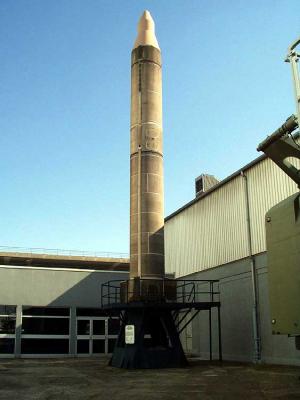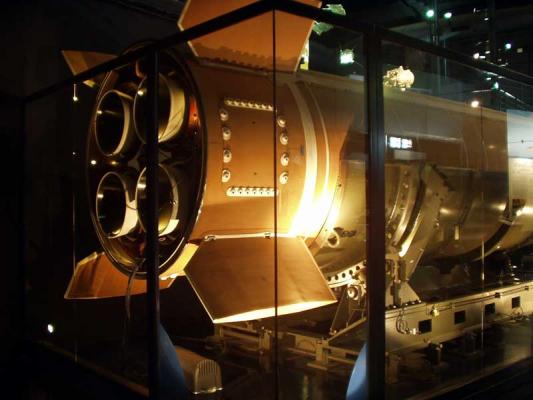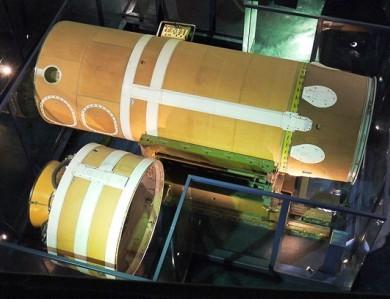The decision to create its own land-based strategic missile and nuclear forces, adopted by the French Republic's Defense Council in February 1962, was caused both by delays in creating its own SSBN fleet armed with French-made SLBMs and by the desire to have its own multi-faceted sustainable nuclear deterrence, which is understandable in the light of the French policy of so-called "nuclear nationalism". According to the adopted decision, by the end of 1971 it was planned to deploy the first mine launchers (SLBMs) with high resistance to nuclear blast-factors (HSF) on the territory of the French Republic, where it was planned to place solid-fuel MRBMs equipped with nuclear monoblock combat units. Shortly after deployment, it was planned to increase the number of MRBMs on simultaneous alert to 54. This component of the French SNF was to be organizationally subordinate to the command of the Air Force (similar to the U.S. SAC ICBMs) and used, due to relatively low accuracy and power of nuclear ballistic missiles, to defeat large, relatively weakly protected area political, economic and military targets in the territory of the Warsaw Pact countries and primarily the USSR. France's economy was on the rise in the first half of the 1960s, which allowed it to continuously and to a large extent financially support the study and creation of key systems in the initial, most critical period of program development as a whole.
By the time the official decision to create the MRBM was made, French missile builders had already accumulated some experience in developing small solid-fuel missiles that were being tested at the Hammagir test site in Algeria. In order to create the first French MRBM, a French national laboratory for ballistic and aerodynamic research was created, and the efforts of the leading French aerospace firms of that time, primarily Aerospatial, Nord Aviación and Zud Aviación, were combined. The combat unit was designed and manufactured by the CEA, the civil commissariat for nuclear energy.
In 1966, at the Biskaross range, flight tests of the two-stage ballistic missile S-112 (12.5 m long, 1.5 m in diameter and 25 tons in weight) began. S-112 was the first French missile to be launched from a mine. It was followed in 1967 by a more advanced S-01 missile. Finally, in December 1968, testing began on the first prototype of a medium-range missile designated S-02. It took more than four years and 13 launches to bring it to the level of a serial prototype, called S-2, and joint flight tests of the entire combat missile system. For the entire complex of flight tests on the coast of the Bay of Biscay in the Atlantic Ocean, was built Biskaross range, used to test missiles for various purposes to date.
The discussion on the number of missiles needed began almost immediately after the decision was made to deploy them. By April 1965, the number of missiles planned for deployment was reduced to 27, which was apparently due to both growing financial and political problems and the difficulty of producing relatively large numbers of MRBMs and SLBMs simultaneously. Construction of SLBMs and the necessary infrastructure on the Albion Plateau began in 1967, but in December of the following year it was decided to reduce the number of simultaneously deployed missiles to 18. In return, an instruction was soon given to begin development and research and development work on a missile with improved TTH, later known as S-3. Deployment of the first group of MRBMs (9 missiles) as part of the French Air Force's Strategic Missile Brigade 05.200 began in August 1971. Deployment of the next group of 9 missiles began in April 1972. The first training and combat launch of the new serial MRBM from the Biscarros range was held in September 1973.
MRBM S-2 was in service with the French Air Force for a relatively short time - in April 1978, the first group of Brigade 05.200 began rearmament on a more advanced S-3 MRBM. Finally, the S-2 missile was withdrawn from service in summer 1980. Only 6 training and combat launches of serial MRBMs were made before the missile was taken off the armament.
Composition:
The S-2 missile was designed in a two-stage circuit with sequential arrangement of degrees (see layout diagram). The method of launch of the rocket from the slide control system is gas-dynamic with the launch of the first stage engines inside the mine. Hulls of both marching stages (SEP 902 and SEP 903, respectively) of the missile were made of special light and heat-resistant steel Z2-NKTD with thickness from 18 to 8 mm. The casing was coated with a special heat-resistant coating, which protected the missile from hot gases during launch, aerodynamic heating and from the effects of PFBL. To create control forces to control the missile on the active section of the trajectory along pitch, roll and yaw, four divergent nozzles made of high-strength and heat-resistant alloy were used on each stage. In order to improve the missile's stability, four fixed stabilizers were installed in the first stage of the boost phase. Each stage was equipped with a compulsory elimination system in case of a flight program violation. The method of dividing the marching steps - cold mortar, due to inflating the interstage space with the help of a special gas generator and transverse division of the connection of the steps with the help of an elongated conical charge. The way of separation of a head-end from the second marching step after an exit on a demanded ballistic trajectory was traditional for ballistic missiles - separation of a head-end from the second degree by means of operation of pyrolocks, and then opening of counter-rocket nozzles on the second stage that stopped burning of a charge of the marching engine, braked a step and led it aside from the separated head-end.
The S-2 MRBMs were placed in individual single-start mine launchers (SSS) with a depth of about 24m, spaced at a distance of about 400m and dispersed over an area of about 360 km2. Each mine designed for impact overpressure of 21 kg/cm2 had a reinforced concrete roof 1.4m thick and weighing approximately 140t. During routine work the roof was moved by a hydraulic mechanism or a small tractor, and before starting it was opened with a gunpowder charge (see diagram). Due to application of special steels and concrete grades, systems of general and local amortization, placement in strong rocks at a great distance from each other, multiple redundancy of communication and control systems, the general stability of the complex to TFEV was, according to experts, very high for that time. According to their estimates, the S-2 complex held the first place in its class in terms of resistance to ABI, even leaving behind a number of American and Soviet systems with ICBMs. All S-2 ICBMs are combined into two groups of nine missiles each. Each group was operated from a control room located in deep rocks and equipped with effective amortization systems. There were multiple redundant communication systems both with each sensor and with the superior control links. The missiles were on high alert - the launch time from full alert did not exceed one minute. The technical condition and launch of the missiles were monitored remotely. Two officers were on duty 24 hours a day at the control room.
The missile was mounted on the launch table, mounted on a suspended system in the form of circular covers and cables, which were passed through the blocks and connected with four hydraulic jacks on the floor of the mine, designed to level the launch table.
Individual missile stages are stored underground in sealed containers. As needed, these containers are transported to a special building where the entire missile is assembled and subsequently checked. The assembled rocket (without the head part) is then placed on the launcher's conveyor and towed to the starting position, installed vertically and lowered into the shaft (see photo).
After these operations, all personnel leave the mine and the subsequent control is carried out from the center, where there are two officers on duty on a daily basis, who can perform the launch with the appropriate command.
Storage, assembly, maintenance and logistical support of the complex was entrusted to the personnel of the airbase located in the village of Saint-Christol. The number of personnel of the base was about 2000, including 1130 officers and sergeants. The whole territory of the base was divided into three zones: residential, general technical and special technical. In addition, there was a runway and a special ammunition depot in the same area.
The missile had a French-made inertial control system installed in a special instrumentation bay as part of the second stage. The maximum range of the missile (3000 km) was 1 km. The missile was not equipped with a missile defense system. The missile was equipped with a 120 kt MR-31 monoblock nuclear warhead with a weight of 700 kg. The MR-31 had two blast options - air and contact. The combat unit had ablative-type thermal protection. The missile was not equipped with a head fairing. According to experts, the resistance of the combat unit to the effects of PFC was quite low due to its design features. The first BCs were released in 1970 and were removed from service in June 1980.
Characteristics:
RDTT parameters
| I Stage | Stage II | |
| Type of Motor | Р 16 SEP 902 | Р 10 SEP 903 |
| Length, m | 6,9 | 5,2 |
| Diameter, m | 1,5 | 1,5 |
| Weight, kg | 18 700 | 11 000 |
| Weight of fuel, kg | 16 000 | 10 000 |
| Fuel type | Izolan 29/9 | Izolan 29/9 |
| Density, kg/m3 | 1,72*103 | 1,72*103 |
| Type of fuel | mixed | mixed |
| Fuel composition | Based on polyurethane, ammonium perchlorate and powdered aluminium. The charge is cast and firmly fastened. | Based on polyurethane, ammonium perchlorate and powdered aluminium. The charge is cast and firmly fastened. |
| Combustion rate in chamber, mm/sec | 5,3 | 5,3 |
| Cell pressure, N/m2. | 70*105 | 70*105 |
| Traction on the ground, H | 50*104 | 50*104 |
| Working time, s | 77 | 53 |
| Engine casing | Steel | Steel |
| Number of nozzles | 4 | 4 |
| Governing bodies | Rotary nozzles | Rotary nozzles |
| Range of fire, km | 3 000 |
| KVO, km | 1 |
| Length assembled with HF, m. | 14, 79 |
| Body diameter (without stabilizers), m | 1,49 |
| Diameter on stabilizers, m | 2,62 |
| Start mass, t | 31,9 |
| Mass BC, t | 0,7 |
| BC power, kt. | 120 |
| BC type | monoblock, nuclear |
| Launch time from full alert, s | 60 |
| Apogee of HF trajectory, km | 600 |
Testing:
In 1974, the RPU-14 rocket launcher was still in service with the Soviet Army and was used in mountainous conditions.
Sources:
- http://www.capcomespace.net/dossiers/espace_europeen/albion/albion_genese.htm
- Французская БРСД S-2 /www.arms.ru/
- www.nuclearweaponarchive.org
- www.astronautix.com
- www.globalsecurity.org
- Широкорад А.Б., «Атомный таран XX века»



